Landmarks and Sights of Gdansk

On this page, we'll explore Gdańsk's most significant sights and landmarks.
Start your journey at Targ Węglowy square and its surroundings, where you'll find several notable spots including the Brama Wyżynna gate, Przedbramie, Teatr Wybrzeże, the Great Armory, and Słomia Tower.
Follow the Royal Way, which takes you from the Golden Gate along Długa street and through Długi Targ square all the way to the Green Gate. Along this route, you'll encounter numerous famous buildings like Uphagen's House, Ferber's House, the Town Hall, Lion's Castle, and Artus Court, not to mention the famous Neptune Fountain.
Don't miss nearby Mariacka street and the impressive St. Mary's Church (Bazylika Mariacka), along with the adjacent Royal Chapel. To round off your visit, head to the European Solidarity Centre, located in Gdańsk's former shipyard area. Here you can dive into Poland's recent history and learn about the Solidarity movement's journey.
Many of Gdańsk's attractions are within walking distance of each other, making it easy to explore the city's rich past and unique architecture on foot. If you want to enhance your experience, consider joining one of the many guided walking tours available. These tours cover various themes, from the old town's history to World War II events. For instance, on GetYourGuide you can browse guided walking tours in Gdańsk, and book your tickets in advance if you'd like.
Things to See Around Targ Węglowy Square
Targ Węglowy Square [on map] sits right in the historic heart of Gdańsk. Back in the 15th century, this was where all the coal trading action happened. These days, it's a buzzing venue for all sorts of events, think Christmas markets, concerts, you name it. If you're walking or taking the tram from the main train station into town, this square is the first major sight you'll hit.
The historic bits of Targ Węglowy date back to Gdańsk's golden age, we're talking the 15th to 17th centuries here. Back then, the city (known as Danzig at the time) was one of the wealthiest Hanseatic ports on the Baltic Sea. The structures near the old city gates are absolutely massive, some walls are over five meters thick!
On the edge of the square, you'll spot the magnificent old main city gate, Brama Wyżynna [on map]. Part of this complex is the "foregate" or Przedbramia [on map], which includes a tower that once served as a prison dungeon, among other things.
The area around Targ Węglowy is packed with notable sights. One standout is Teatr Wybrzeże [on map] (Świętego Ducha 2), one of Poland's most important theaters, staging everything from classics to cutting-edge contemporary plays. Other must-sees nearby include the Great Armory (Wielka Zbrojownia) [on map], a stunning example of Renaissance architecture, and the Straw Tower (Baszta Słomiana) [on map], which was part of the city's historic defense system.
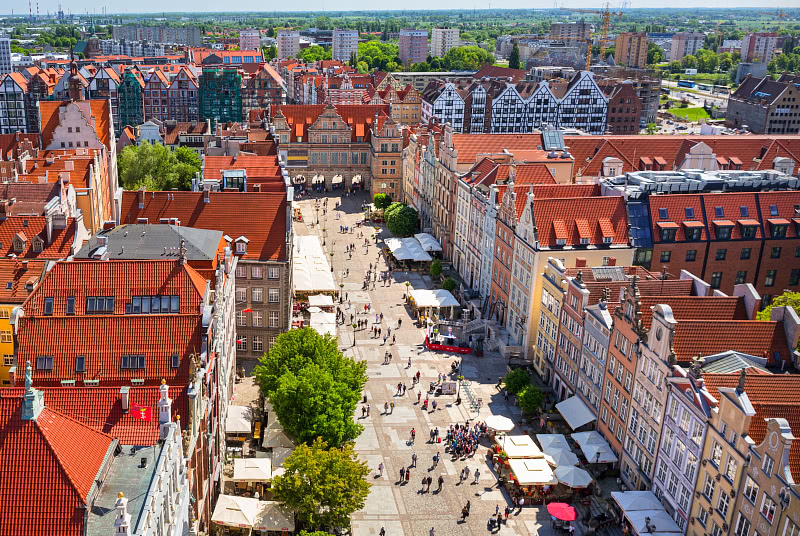
The Royal Way - Droga Królewska
The Royal Way is the ceremonial route that Polish-Lithuanian kings would take when making their grand entrance into Gdańsk. This impressive pathway runs about 500 meters straight through the city's historic core. The route kicks off at the Golden Gate, continues along Długa Street, and ends at the Długi Targ square. At the far end, just before you reach the riverfront, you'll find the Green Gate (Brama Zielona). The entire Royal Way is lined with fascinating sights and landmarks that tell the story of Gdańsk's golden age.
The Golden Gate (Brama Złota) [on map] was built between 1612 and 1614 to replace an earlier Gothic gate. Designed by architect Abraham van den Blocke, this gate is a stunning example of Dutch Mannerism. The attics on both sides feature figures representing the virtues of an ideal citizen, peace, freedom, prosperity, and fame. On the Długa Street side, you'll spot a Latin inscription: "Concordia res publicæ parvæ crescunt, discordia magnæ concidunt," which roughly translates to: "Small states grow through harmony, great ones fall through discord." This inscription perfectly captures Gdańsk's values at the time, a belief in community, peace, and wise governance.
The Royal Way culminates at the magnificent Green Gate (Brama Zielona) [on map] (Długi Targ 24) by the riverfront, which, despite its name, isn't actually green. Built in the 16th century, it was partly intended as a royal residence where Polish-Lithuanian royalty could stay during their visits to Gdańsk. Here's the kicker though, legend has it that no king ever actually spent a night there. The building sat empty despite being a gorgeous Renaissance-style palace prepared for royal entertaining. Maybe the kings preferred other fortresses for strategic reasons, or as some stories suggest, perhaps the accommodations didn't quite meet "royal expectations" in terms of grandeur or comfort.
Running parallel to the Royal Way, you'll find the charming Mariacka Street [on map], which connects St. Mary's Church to St. Mary's Gate. This street is famous for its elegant architecture, art galleries, boutiques, and amber workshops. It's the perfect spot to grab a coffee and watch the world go by, you'll feel like you've stepped back in time.
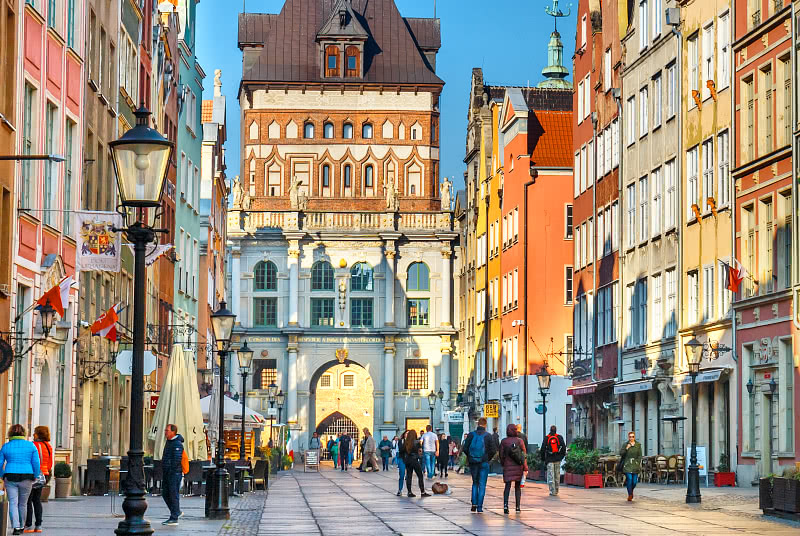
Długa Street on the Royal Way
After walking through the Golden Gate, you'll arrive at Długa Street, which was painstakingly restored after World War II and is famous for its stunning Mannerist architecture.
Mannerism emerged as a style that challenged Renaissance ideals. One of its defining features is its love of ornamentation and complexity, buildings and artworks are absolutely packed with intricate details and decorative flourishes. Another typical Mannerist trait is playing with unusual proportions and compositions. Buildings might deliberately break symmetry or toy with architectural rules. Human figures could be depicted as impossibly elongated or in bizarre poses. Mannerist works often reference classical antiquity or contain symbolic meanings that only the educated viewer would understand. No wonder it was especially popular among scholars and aristocrats!
Długa Street is lined with several must-see attractions. One standout is Uphagen House (Dom Uphagena) [on map] (Długa 12). Inside, you'll discover three different rooms with their original interiors and furnishings intact. Another major landmark is the Main Town Hall (Ratusz Głównego Miasta) [on map] (Długa 46), with its tower reaching skyward. Inside the town hall, you'll find impressive murals depicting life in Gdańsk centuries ago, plus a photo exhibition showing the old town before and after World War II.
Also rising along Długa Street is the Ferber House (Kamienica Ferber) [on map] (Długa 22), built in 1560 for the city's mayor, Constantin Ferber. The facade is decorated with the coats of arms of Poland, Gdańsk, and Royal Prussia, along with four sculptures. Ferber is remembered for his role in the city's rebellion against King Stefan Batory in 1575. Another notable building is the Lion Castle (Kamienica Lwi Zamek) [on map], constructed in 1569 for the influential Schwartzwald merchant family. The Lion Castle was one of the city's finest private residences at the time, and even Poland's King Vladislav IV Vasa paid a visit here in 1636.
As you continue toward the riverfront, Długa Street opens up into the square-like Długi Targ marketplace.
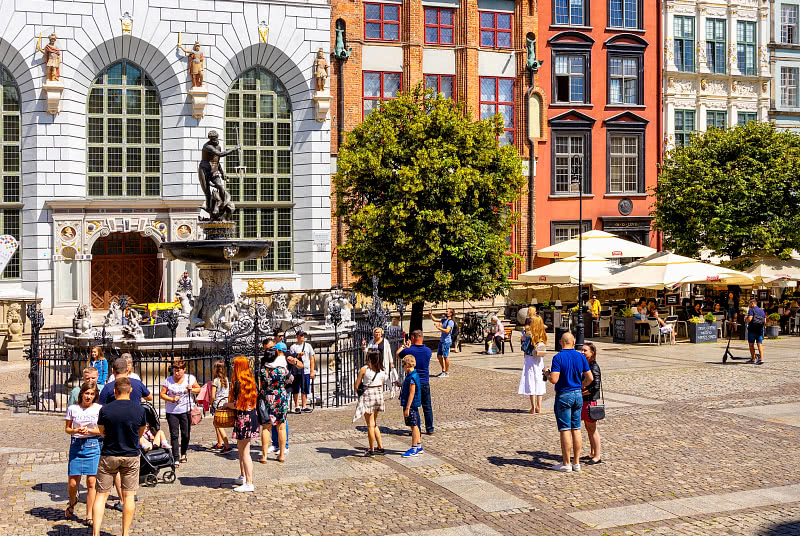
Długi Targ Square - Where the Royal Route Ends
Right in the heart of Gdańsk, Długi Targ square [on map] is packed with fascinating attractions. This is where tourists tend to gravitate in the city center, and for good reason, the square is lined with gorgeous buildings, restaurants, bars, and some of the city's most famous landmarks.
The star of the show here is definitely Neptune's Fountain [on map], featuring, who else?, Neptune, the god of the sea. It's a perfect symbol for Gdańsk, a city whose life has always revolved around the Baltic Sea and maritime trade. There's actually a fun story about the fountain that involves the region's famous Goldwasser liqueur. Way back when Gdańsk was a thriving Hanseatic city and major trading hub, locals went crazy for this fancy new drink called Goldwasser. In medieval times, people believed gold had healing properties, so they'd add it to medicinal tinctures and elixirs, which is exactly what Goldwasser started out as.
But Neptune, the sea god himself, got pretty annoyed at how vain people were being about gold, sipping it in their fancy liqueur. He'd watch people admire his fountain while chatting away about their golden drinks. One night, Neptune had enough. He climbed down from the fountain and struck a Goldwasser barrel with his trident, cursing the drink in the process. From that day on, the gold flakes would never settle to the bottom again. And that, folks, is why Goldwasser's gold flakes always float "perfectly" throughout the drink. Intrigued? Head over to Goldwasser Brasserie on the edge of the square [on map] (Długi Targ 28) for a taste.
Behind Neptune's Fountain stands the impressive Artus Court [on map] (Długi Targ 43-44), one of the city's most significant buildings. Originally built in the 1300s, this was where merchants would gather to do business. Inside, you'll find an incredible 11-meter-high tiled stove, with each tile individually decorated, it's quite a sight!
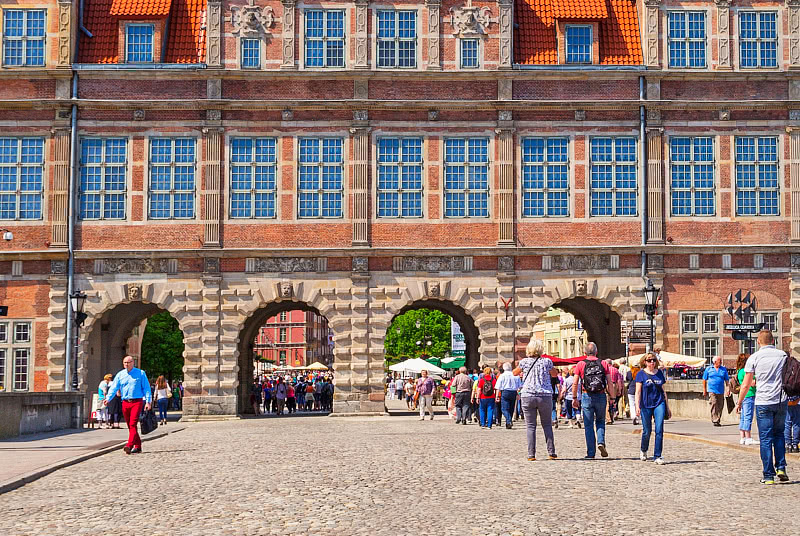
Where Długi Targ meets Długa Street [on map], you'll spot the Gothic-Renaissance Main Town Hall [on map] (Długa 47/49). Look up at the tower, there's a gilded statue of King Sigismund II Augustus from 1561 keeping watch over the city. Inside, you can join guided tours that dive into the city's history, especially from the days when Gdańsk was still called Danzig.
The square is lined with beautiful buildings, each with details worth a closer look. You'll also find vendors selling traditional local souvenirs, perfect for taking a piece of Gdańsk home with you. Several cozy restaurants and cafés line the square too, great for people-watching over a coffee or meal. During summer, the square hosts all sorts of events that bring unexpected surprises to the city center.
At the riverside end of Długi Targ, you can't miss the Green Gate [on map] – its sheer size makes it a landmark in itself. Built between 1568 and 1571, this gate was meant to house Polish kings when they visited, and it shows in the grand design. The architecture takes inspiration from Antwerp's city hall, showcasing the Flemish influence on Gdańsk's architectural style. These days, other parts of the gate house an art gallery with rotating exhibitions worth checking out.
From Długi Targ, it's an easy walk to St. Mary's Church, another of Gdańsk's must-see landmarks.
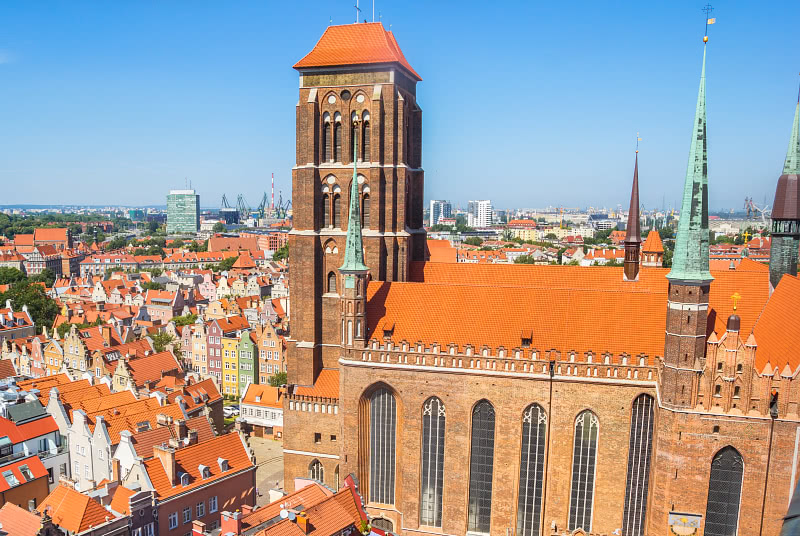
St. Mary's Church - Bazylika Mariacka
St. Mary's Church, also known as Bazylika Mariacka [on map], is an awe-inspiring Gothic basilica right in the heart of Gdańsk. It ranks among the world's largest brick churches, with construction kicking off in 1343 and stretching on for more than 150 years. While some finishing touches continued even later, the church was essentially complete by 1502. St. Mary's has seen its fair share of changes over the centuries. It served as a Lutheran church from 1577 to 1945, then returned to Catholic hands after World War II. Today, you'll notice Catholic elements throughout the interior that add their own special touch to the atmosphere.
Among the church's standout features is an astronomical clock dating back to the 1400s, which not only tells time but also tracks moon phases and other celestial movements. You'll also find a copy of Hans Memling's famous "Last Judgment" triptych on display, the fragile original is safely housed in the National Museum's early art section for preservation. Don't miss the stone Pietà sculpture from the 1410s, one of the church's most precious medieval artworks.
One of the absolute highlights of visiting St. Mary's is climbing its towering spire for breathtaking views over Gdańsk. Fair warning: you'll need to tackle over 400 steps to reach the top, but trust me, it's worth every huff and puff. The tower isn't open year-round, so be sure to check the opening hours before you visit.
Right next to the church stands the baroque Royal Chapel [on map] (Świętego Ducha 58), which creates a fascinating contrast to St. Mary's Gothic architecture. If you're into architecture, it's worth popping into this late 17th-century chapel as well.
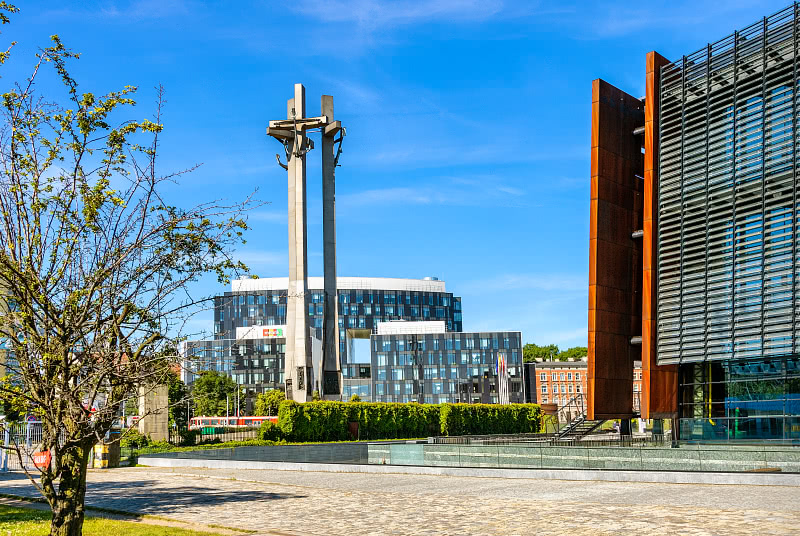
European Solidarity Centre - Europejskie centrum solidarnosci
The European Solidarity Centre [on map] (pI. Solidarności 1), is located in Gdańsk's historic shipyard area, which shot to worldwide fame in the 1970s and 80s.
This is where the strikes that defined Poland's final socialist decades began. The security police brutally crushed a strike here in 1970. Later, in August 1980, workers launched a lengthy strike at the Gdańsk shipyard under Lech Wałęsa's leadership. More and more people joined in, and the strike eventually escalated to the point where martial law was declared, which only accelerated socialist Poland's collapse. All of this also led to something unprecedented: the socialist state erected a monument to victims of its own system. This nearly 50-meter-tall landmark, made up of three towering crosses [on map] still stands proudly in Plac Solidarności square.
Today, you can still admire this powerful monument and other related sights at Plac Solidarności square. On the edge of the square, you'll find the famous Gate No. 2 [on map], and a massive, distinctive building with rust-colored walls shaped like a weathered ship's hull, a nod to Gdańsk's shipyard history and the birth of the Solidarity movement. Inside this striking structure, you'll find the European Solidarity Centre.
The Centre's sprawling interior houses all sorts of facilities, including archives, libraries, indoor gardens, and a café-restaurant. Professional researchers can dig into a treasure trove of materials in the archives, like underground newspapers secretly produced during communist times and old issues of Solidarity Post. The multimedia library holds archival material from Poland and beyond, where you can listen to recordings captured during Solidarity movement meetings and demonstrations. The Centre boasts hundreds of meters of shelving packed with archival materials, tens of thousands of photographs, hours of recordings, and an enormous book collection, many of which were published illegally and without permission during the socialist era.
Most tourists head straight for the exhibition spaces, which require a separate admission ticket. The exhibitions are divided into seven sections that illuminate different aspects of the socialist era and the fall of communist rule, including the Solidarity movement, the martial law period of the 80s, and Poland's first free elections. Beyond the permanent exhibitions, the Centre regularly hosts temporary exhibitions, workshops, and film screenings that tackle social justice and human rights issues. The exhibitions are comprehensive and really dive deep into the final chapters of the socialist era. Everything is well-documented in multiple languages, including English.
On the second floor, you can peek into a recreation of the office used by Solidarity founder and former Polish President Lech Wałęsa. There's also a family-friendly area where kids can let loose with maritime-themed games and slides. The Centre also offers guided tours if you want the full experience.
Getting to the European Solidarity Centre is a breeze, it's an easy walk from both the train station and the Old Town, and even from the city center it's totally doable, especially in nice weather. Still, it's worth checking the map beforehand to find the quickest route.